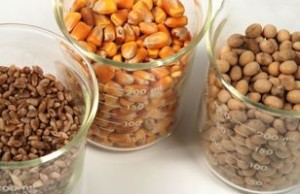 Grain futures were mixed but fairly unchanged on Tuesday, with soybeans slightly falling, while wheat marked a minor gain and corn rebounded from a new 3-year low.
Grain futures were mixed but fairly unchanged on Tuesday, with soybeans slightly falling, while wheat marked a minor gain and corn rebounded from a new 3-year low.
On the Chicago Board of Trade, corn futures for September delivery traded at $4.6938 a bushel at 10:15 GMT, up 0.17% on the day. Prices ranged between days high at $4.6938 and low at $4.6563, the lowest level since August 2010. The grain fell 1.37% on Monday, a third consecutive daily decline, extending its weekly fall to over 1.3% after plunging 12.8% in the previous three weeks.
Corn continued to mark new multi-month lows as the U.S. Department of Agriculture said in its weekly crop progress report yesterday corn silking advanced from last week and is nearing the five-year average pace. Silking is part of the pollination stage, during which the crop can be hurt by drought and high temperatures. Weather forecasters have been calling in the last couple of weeks for cool and rainy weather across U.S. growing areas, which is supportive for both corn and soybeans growing. DTN said yesterday that mild temperatures in the Midwest through the first half of August will benefit corn pollination and soil moisture in the southern and eastern areas will aid pod-filling soybeans.
The USDA said in its report that as of the week ending August 4, 86% of the corn plants were in the silking stage, compared to 71% a week earlier. This was near the five-year average of 89%, but below last years reading of 98%.
Michael Pitts, a commodity sales director at National Australia Bank Ltd., said for Bloomberg yesterday: “Silking’s a bit more progressed, almost back to the average, so most of the concerns are probably out of the way. We’ve had some pretty decent weather in the corn belt in the U.S. over the last week or so which should continue. The crops have been improving.”
As for the crop condition, it was overall the same like the previous week and a lot better than last years drought damaged crop. As of last week, 11% of the corn plants were rated as very poor-poor, compared to 50% during the comparable week last year. Meanwhile, 25% of the crop was categorized as “Fair”, a bit below 2012s 27%. As for the premium quality, 64% of corn plants fell in the “Good” and “Excellent” categories, compared to 23% a year earlier.
Meanwhile, U.S.s biggest grain crop was also supported as analysts expect a higher output this season than USDAs forecast. The government agency trimmed its latest output projection to 13.95 billion bushels, down from 14.005 billion, but that was however still an all-time record high. According to a Bloomberg survey, farmers may reap a record 14.036 billion bushels of corn this year, 30% more than last years production. The USDA will publish a revision of its projections at noon on August 12.
Soybeans fall
Meanwhile, soybeans traded lower on the day despite rebounding off Mondays freshly hit 17-month low. On the Chicago Board of Trade, soybeans for delivery in September traded at $12.0663 per bushel at 10:15 GMT, down 0.05% on the day. Prices ranged between days high and low of $12.0988 and $12.0250 a bushel respectively. The oilseed slipped 0.27% on Monday, a 10th consecutive daily decline, extending this weeks fall to 0.4% after falling 19.6% the preceding two.
Soybeans tumbled 3.7% in July, marking a second monthly decline in a row. The oilseed slumped this year as the USDA projected domestic output will jump by 13% to a record 3.42 billion bushels, which would boost global inventories by 20% to an all-time record high of 74.1 million tons. The grain was well supported by favorable weather conditions in U.S. growing areas, which led to an almost 20% decline since the week beginning July 21.
The USDA said in its report yesterday that as of August 14, 79% of the soybean plants had bloomed, up from 65% in the previous week and nearing the five-year average of 85%. During the comparable week a year earlier, 93% of the soybean crop was in the blooming stage.
As for the crop condition, the government agency said quality was almost the same as the previous week but marked a large improvement compared to the previous season. As of August 4, 9% of the soybean plants were categorized as “Very poor” and “Poor”, compared to 39% in 2012. Meanwhile, 27% of the crop was of “Fair” quality, below last years 32%. As for the premium quality, 64% of soybeans were rated good-excellent, well above last seasons 29% during the comparable week.
Wheat slightly up
Wheat traded mostly lower throughout the day but rose back to positive territory and stood at $6.4538 a bushel at 10:20 GMT, up 0.15%. Futures ranged between days high and low of $6.4638 and $6.4238 a bushel respectively. The grain plunged 2.27% on Monday, extending current weeks decline to over 2.2% after advancing 1.69% the preceding one.
In its crop progress report, the USDA said that winter wheat harvesting surpassed the five-year average pace and almost equaled last years progress. As of August 4, 87% of the crop was reaped, up from 81% in the preceding week. This was 1% above the five-year average of 86% and a bit below last years 89%.
As for the spring wheat, the USDA reported heading advanced to 97% last week, 3% above the preceding weeks pace and 1% below the five-year average of 98%. During the comparable period in 2012, 100% of the crop was headed.
The government agency also said in its report that wheat condition was moderately better than last seasons crop. As of August 4, 7% of the spring wheat was categorized as “Very poor” and “Poor”, compared to 11% a year earlier. Plants in the “Fair” category were 1% less than in 2012, standing at 25%. As for the top quality, 68% was rated good-excellent, above last years 63% during the comparable week.





